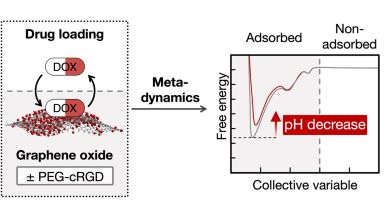
Graphene oxide is an amphiphilic and versatile nanomaterial that holds great promise for pH-triggered drug delivery, which aims to administer chemotherapeutic drugs such as doxorubicin to cancer cells in a spatially and temporally controlled manner. However, the mechanism and the molecular interactions involved in the absorption of doxorubicin on graphene oxide and its sensitivity to a pH decrease are still poorly understood.
In this context, the NanoQlab research group, led by Prof. Cristiana Di Valentin (Department of Materials Science, University of Milano-Bicocca), in collaboration with Dr. Stefano Motta (Department of Earth and Environmental Sciences, University of Milano-Bicocca), performed a series of metadynamics simulations to uncover the most common modes of adsorption of doxorubicin on different graphene oxide nanocarriers and to identify the ideal features of graphene-based drug carriers. The findings of this study, which were published in the article entitled "Unveiling the drug delivery mechanism of graphene oxide dots at the atomic scale" in the Journal of Controlled Release (Impact Factor 10.5, 2023 Journal Impact Factor, Journal Citation Reports (Clarivate Analytics, 2024)), also demonstrated that a change in pH from neutral to acidic conditions, i.e. from those typical of healthy tissues to those of the tumor microenvironment, causes a decrease in the affinity between doxorubicin and graphene oxide, providing a molecular explanation for the pH-triggered drug release mechanism.